Tsutomu Yamaguchi, born 16-03-1916 in Nagasaki, 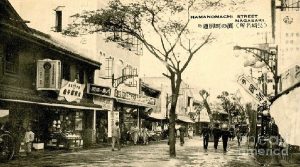 joined Mitsubishi Heavy Industries in the 1930s and worked as a draftsman designing oil tankers. Yamaguchi “never thought Japan should start a war”. He continued his work with Mitsubishi Heavy Industries, but soon Japanese industry began to suffer heavily as resources became scarce and tankers were sunk. As the war ground on, he was so despondent over the state of the country that he considered killing his family with an overdose of sleeping pills in the event that Japan lost.
joined Mitsubishi Heavy Industries in the 1930s and worked as a draftsman designing oil tankers. Yamaguchi “never thought Japan should start a war”. He continued his work with Mitsubishi Heavy Industries, but soon Japanese industry began to suffer heavily as resources became scarce and tankers were sunk. As the war ground on, he was so despondent over the state of the country that he considered killing his family with an overdose of sleeping pills in the event that Japan lost.
Yamaguchi 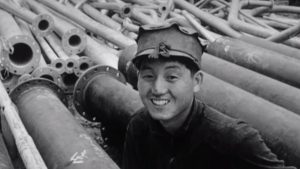
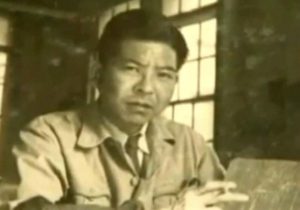 lived and worked in Nagasaki, but in the summer of 1945 he was in Hiroshima for a three-month-long business trip. On August 6 he was preparing to leave the city with two colleagues, Akira Iwanaga
lived and worked in Nagasaki, but in the summer of 1945 he was in Hiroshima for a three-month-long business trip. On August 6 he was preparing to leave the city with two colleagues, Akira Iwanaga 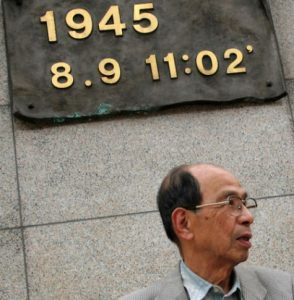 and Kuniyoshi Sato
and Kuniyoshi Sato ![]()
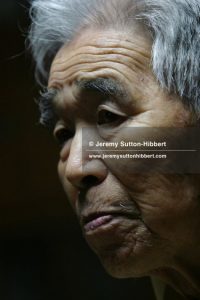 , and was on his way to the station when he realised he had forgotten his hanko (a stamp allowing him to travel), and returned to his workplace to get it. At 8:15 am, he was walking towards the docks when the American bomber Enola Gay.
, and was on his way to the station when he realised he had forgotten his hanko (a stamp allowing him to travel), and returned to his workplace to get it. At 8:15 am, he was walking towards the docks when the American bomber Enola Gay.  The Enola Gay is a Boeing B-29 Superfortress bomber, named after Enola Gay Tibbets, the mother
The Enola Gay is a Boeing B-29 Superfortress bomber, named after Enola Gay Tibbets, the mother  of the pilot, Colonel Paul Tibbets. With pilot Paul Tibbets, they dropped the Little Boyatomic bomb
of the pilot, Colonel Paul Tibbets. With pilot Paul Tibbets, they dropped the Little Boyatomic bomb
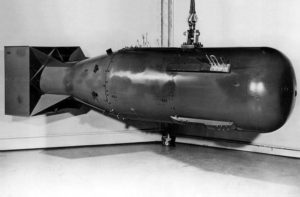
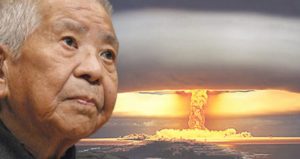 near the centre of the city, only 3 km away. Yamaguchi recalls seeing the bomber and two small parachutes, before there was “a great flash in the sky, and I was blown over”. The explosion ruptured his eardrums, blinded him temporarily, and left him with serious burns over the left side of the top half of his body. After recovering, he crawled to a shelter, and having rested, he set out to find his colleagues They had also survived and together they spent the night in an air-raid-shelter before returning to Nagasaki the following day.In Nagasaki, he received treatment for his wounds, and despite being heavily bandaged, he reported for work on August 9.
near the centre of the city, only 3 km away. Yamaguchi recalls seeing the bomber and two small parachutes, before there was “a great flash in the sky, and I was blown over”. The explosion ruptured his eardrums, blinded him temporarily, and left him with serious burns over the left side of the top half of his body. After recovering, he crawled to a shelter, and having rested, he set out to find his colleagues They had also survived and together they spent the night in an air-raid-shelter before returning to Nagasaki the following day.In Nagasaki, he received treatment for his wounds, and despite being heavily bandaged, he reported for work on August 9.
The 13-kiloton uranium atomic bomb, known as Little Boy, destroyed much of Hiroshima. Just three kilometers from the epicenter of the blast, Yamaguchi was violently pushed back before instinctively taking cover in an irrigation ditch. A nautical engineer, he’d been sent to Hiroshima three months earlier by his boss at Mitsubishi Heavy Industries to work on an oil tanker. It was supposed to be his penultimate day in the city and he was desperate to get back to his family.
“He had to cross a river that was full of bloated corpses of men, women and children, some of whom were stuck together.”
Suffering from a ruptured eardrum and badly burned on the upper part of his body, the then 29-year-old spent an anxious night at an air raid-shelter with colleagues. Passing through scenes of anguish and torment, he then headed toward to the west of the city the following day to get to the station.
At 11 am on August 9, Yamaguchi was describing the blast in Hiroshima to his supervisor, when the American bomber Bockscar 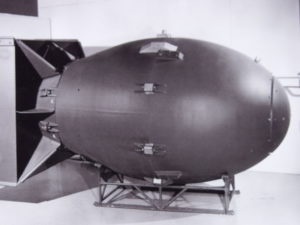
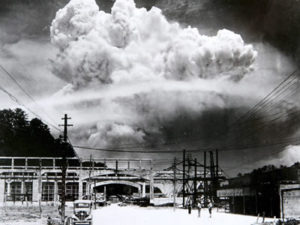 with pilot Major Charles William Sweeney,
with pilot Major Charles William Sweeney,

 dropped the Fat Man atomic bomb over the city. His workplace again put him 3 km from ground zero, but this time he was unhurt by the explosion. However, he was unable to replace his now ruined bandages, and he suffered from a high fever for over a week.
dropped the Fat Man atomic bomb over the city. His workplace again put him 3 km from ground zero, but this time he was unhurt by the explosion. However, he was unable to replace his now ruined bandages, and he suffered from a high fever for over a week.
When the war ended, Yamaguchi worked as a translator for the occupying American Marines and then became a schoolmaster. He later returned to work for Mitsubishi designing oil tankers. When the Japanese government officially recognized atomic bombing survivors as hibakusha in 1957, Yamaguchi’s identification stated only that he had been present at Nagasaki. He was content with this, satisfied that he was relatively healthy, and put the experiences behind him.
As he grew older, his opinions about the use of atomic weapons began to change. In his eighties, he wrote a book about his experiences as well as a book of poetry and was invited to take part in a 2006 documentary about 165 double A-bomb survivors (known as nijū hibakusha in Japan) called Twice Survived: The Doubly Atomic Bombed of Hiroshima and Nagasaki, which was screened at the United Nations At the screening, he pleaded for the abolition of atomic weapons.
Yamaguchi became a vocal proponent of nuclear disarmament. He told an interviewer “The reason that I hate the atomic bomb is because of what it does to the dignity of human beings.” Speaking through his daughter during a telephone interview, he said, “I can’t understand why the world cannot understand the agony of the nuclear bombs. How can they keep developing these weapons?”
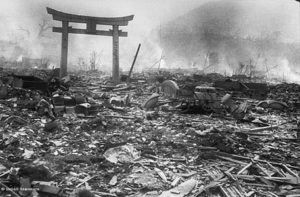
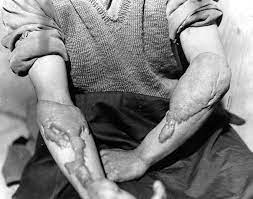 At first, Yamaguchi did not feel the need to draw attention to his double survivor status. However, in later life he began to consider his survival as destiny, so in January 2009, he applied for double recognition. This was accepted by the Japanese government in March 2009, making Yamaguchi the only person officially recognised as a survivor of both bombings. Speaking of the recognition, he said, “My double radiation exposure is now an official government record. It can tell the younger generation the horrifying history of the atomic bombings even after I die.”
At first, Yamaguchi did not feel the need to draw attention to his double survivor status. However, in later life he began to consider his survival as destiny, so in January 2009, he applied for double recognition. This was accepted by the Japanese government in March 2009, making Yamaguchi the only person officially recognised as a survivor of both bombings. Speaking of the recognition, he said, “My double radiation exposure is now an official government record. It can tell the younger generation the horrifying history of the atomic bombings even after I die.”
Dearth and burial ground of Tsutomu Yamaguchi.


 Yamaguchi lost hearing in his left ear as a result of the Hiroshima explosion. He also went bald temporarily and his daughter recalls that he was constantly swathed in bandages until she reached the age of 12 Despite this, Yamaguchi went on to lead a healthy life. Late in his life, he began like many of the approximately 260,000 survivors of the atomic bombings to suffer from radiation-related ailments, including cataracts and acute leukemia.
Yamaguchi lost hearing in his left ear as a result of the Hiroshima explosion. He also went bald temporarily and his daughter recalls that he was constantly swathed in bandages until she reached the age of 12 Despite this, Yamaguchi went on to lead a healthy life. Late in his life, he began like many of the approximately 260,000 survivors of the atomic bombings to suffer from radiation-related ailments, including cataracts and acute leukemia. 
His wife also suffered radiation poisoning from black rain after the Nagasaki explosion and died in 2010 (age 93) of kidney and liver cancer after a lifetime of illness. All three of their children reported suffering from health problems likely connected with their parents’ exposures. In 2009, Yamaguchi learned that he was dying of stomach cancer. He died on 04-01- 2010 in Nagasaki at the age of 93 and is buried on Nagasaki cemetery.

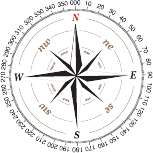















Leave a Reply